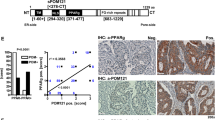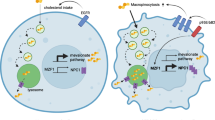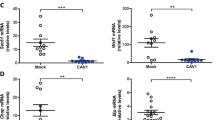Abstract
Peroxisome proliferator-activated receptor-γ (PPARγ) is a nuclear receptor for eicosanoids that promotes differentiation of human epithelial and mesenchymal cells in vitro and in vivo. PPARγ was proposed as a target for drug-induced differentiation therapy of cancer. Caveolin-1 is a constituent of plasma membrane caveolae in epithelial cells that is often downregulated upon oncogenic transformation. Caveolin-1 has growth-inhibitory activities and its disruption is sufficient to induce transformation in fibroblasts. Herein we have tested the hypothesis that caveolins are transcriptional target genes for PPARγ. In human HT-29 colon carcinoma cells, thiazolidinedione PPARγ ligands increased the levels of caveolin-1 and caveolin-2 proteins two to fivefold in a concentration-dependent manner within 24 h. In human MCF-7 breast adenocarcinoma cells, nonthiazolidinedione PPARγ ligands elevated caveolin-2 protein three to fourfold, while the thiazoli-dinediones were less effective. Caveolin-1 mRNA levels were found to be upregulated by PPARγ ligands already after 3 h in both the cell lines. Ectopic expression of a dominant-negative PPARγ construct attenuated ligand-induced upregulation of caveolins in both HT-29 and HEK-293T cells, indicating that ligand action is mediated by PPARγ. Ligand-treated MCF-7 cells exhibited a differentiated phenotype, as evinced by analysis of cell-specific differentiation markers: protein levels of maspin were elevated and perinuclear lipid droplets accumulated. In contrast, in HT-29 cells, caveolin expression was not correlated with differentiation. Interestingly, PPARγ partially cofractionated in lipid rafts and could be coimmunoprecipitated from cell lysates with caveolin-1, indicating that PPARγ and caveolin-1 may coexist in a complex. Our data indicate that PPARγ participates in the regulation of caveolin gene expression in human carcinoma cells and suggest that caveolin-1 may mediate some of the phenotypic changes induced by this nuclear receptor in cancer cells. These findings may have potentially important functional implications in the context of cancer differentiation therapy and multidrug resistance.
This is a preview of subscription content, access via your institution
Access options
Subscribe to this journal
Receive 50 print issues and online access
$259.00 per year
only $5.18 per issue
Buy this article
- Purchase on Springer Link
- Instant access to full article PDF
Prices may be subject to local taxes which are calculated during checkout








Similar content being viewed by others

Abbreviations
- 15dPGJ2:
-
15-desoxy-Δ12,14-prostaglandin J2
- MDR:
-
multidrug resistance
- PhAc:
-
phenyl acetate
- PPARγ:
-
peroxisome proliferator-activated receptor-γ
- PPRE:
-
PPAR-responsive element
- RXR:
-
retinoid X receptor
References
Anderson RGW . (1998). Annu. Rev. Biochem., 67, 199–225.
Bagnoli M, Tomassetti A, Figini M, Flati S, Dolo V, Canevari S and Miotti S . (2000). Oncogene, 19, 4754–4763.
Bender FC, Reymond MA, Bron C and Quest AF . (2000). Cancer Res., 60, 5870–5878.
Biederer CH, Ries SJ, Moser M, Florio M, Israel MA, McCormick F and Buettner R . (2000). J. Biol. Chem., 275, 26245–26251.
Bist A, Fielding CJ and Fielding PE . (2000). Biochemistry, 39, 1966–1972.
Bist A, Fielding PE and Fielding CJ . (1997). Proc. Natl. Acad. Sci. USA, 94, 10693–10698.
Brown DA . (2001). Curr. Biol., 11, R446–R449.
Brown DA and London E . (2000). J. Biol. Chem., 275, 17221–17224.
Campbell L, Hollins AJ, Al-Eid A, Newman GR, von Ruhland C and Gumbleton M . (1999). Biochem. Biophys. Res. Commun., 262, 744–751.
Demetri GD, Fletcher CD, Mueller E, Sarraf P, Naujoks R, Campbell N, Spiegelman BM and Singer S . (1999). Proc. Natl. Acad. Sci. USA, 96, 3951–3956.
Elstner E, Muller C, Koshizuka K, Williamson EA, Park D, Asou H, Shintaku P, Said JW, Heber D and Koeffler HP . (1998). Proc. Natl. Acad. Sci. USA, 95, 8806–8811.
Engelman JA, Chu C, Lin A, Jo H, Ikezu T, Okamoto T, Kohtz DS and Lisanti MP . (1998a). FEBS Lett., 428, 205–211.
Engelman JA, Lee RJ, Karnezis A, Bearss DJ, Webster M, Siegel P, Muller WJ, Windle JJ, Pestell RG and Lisanti MP . (1998b). J. Biol. Chem., 273, 20448–20455.
Engelman JA, Wykoff CC, Yasuhara S, Song KS, Okamoto T and Lisanti MP . (1997). J. Biol. Chem., 272, 16374–16381.
Engelman JA, Zhang XL and Lisanti MP . (1998c). FEBS Lett., 436, 403–410.
Engelman JA, Zhang XL and Lisanti MP . (1999a). FEBS Lett., 448, 221–230.
Engelman JA, Zhang XL, Razani B, Pestell RG and Lisanti MP . (1999b). J. Biol. Chem., 274, 32333–32341.
Fajas L, Debril MB and Auwerx J . (2001). J. Mol Endocrinol., 27, 1–9.
Fielding CJ and Fielding PE . (2001). Biochim. Biophys. Acta, 1529, 210–222.
Fiucci G, Czarny M, Lavie Y, Zhao D, Berse B, Blusztajn JK and Liscovitch M . (2000). Int. J. Cancer, 85, 882–888.
Fiucci G, Ravid D, Reich R and Liscovitch M . (2002). Oncogene, 21, 2365–2375.
Fra AM, Mastroianni N, Mancini M, Pasqualetto E and Sitia R . (1999). Genomics, 56, 355–356.
Fra AM, Pasqualetto E, Mancini M and Sitia R . (2000). Gene, 243, 75–83.
Galbiati F, Volonte D, Engelman JA, Watanabe G, Burk R, Pestell RG and Lisanti MP . (1998a). EMBO J., 17, 6633–6648.
Galbiati F, Volonte' D, Gil O, Zanazzi G, Salzer JL, Sargiacomo M, Scherer PE, Engelman JA, Schlegel A, Parenti M, Okamoto T and Lisanti MP . (1998b). Proc. Natl. Acad. Sci. USA, 95, 10257–10262.
Gobert C, Skladanowski A and Larsen AK . (1999). Proc. Natl. Acad. Sci. USA, 96, 10355–10360.
Hurlstone AF, Reid G, Reeves JR, Fraser J, Strathdee G, Rahilly M, Parkinson EK and Black DM . (1999). Oncogene, 18, 1881–1890.
Kilgore MW, Tate PL, Rai S, Sengoku E and Price TM . (1997). Mol. Cell. Endocrinol., 129, 229–235.
Kitamura S, Miyazaki Y, Shinomura Y, Kondo S, Kanayama S and Matsuzawa Y . (1999). Jpn. J. Cancer Res., 90, 75–80.
Koleske AJ, Baltimore D and Lisanti MP . (1995). Proc. Natl. Acad. Sci. USA, 92, 1381–1385.
Kubota T, Koshizuka K, Williamson EA, Asou H, Said JW, Holden S, Miyoshi I and Koeffler HP . (1998). Cancer Res., 58, 3344–3352.
Lavie Y, Fiucci G and Liscovitch M . (1998). J. Biol. Chem., 273, 32380–32383.
Lee SW, Reimer CL, Oh P, Campbell DB and Schnitzer JE . (1998). Oncogene, 16, 1391–1397.
Lefebvre M, Paulweber B, Fajas L, Woods J, McCrary C, Colombel JF, Najib J, Fruchart JC, Datz C, Vidal H, Desreumaux P and Auwerx J . (1999). J. Endocrinol., 162, 331–340.
Li L, Yang G, Ebara S, Satoh T, Nasu Y, Timme TL, Ren C, Wang J, Tahir SA and Thompson TC . (2001a). Cancer Res., 61, 4386–4392.
Li WP, Liu P, Pilcher BK and Anderson RG . (2001b). J. Cell Sci., 114, 1397–1408.
Lisanti MP, Tang Z, Scherer PE and Sargiacomo M . (1995). Methods Enzymol., 250, 655–668.
Liu J, Wang XB, Park DS and Lisanti MP . (2002). J. Biol. Chem., 277, 10661–10668.
Lu ML, Schneider MC, Zheng Y, Zhang X and Richie JP . (2001). J. Biol. Chem., 276, 13442–13451.
Matveev S, van der Westhuyzen DR and Smart EJ . (1999). J. Lipid Res., 40, 1647–1654.
Mueller E, Sarraf P, Tontonoz P, Evans RM, Martin KJ, Zhang M, Fletcher C, Singer S and Spiegelman BM . (1998). Mol. Cell, 1, 465–470.
Mueller E, Smith M, Sarraf P, Kroll T, Aiyer A, Kaufman DS, Oh W, Demetri G, Figg WD, Zhou XP, Eng C, Spiegelman BM and Kantoff PW . (2000). Proc. Natl. Acad. Sci. USA, 97, 10990–10995.
Murphy GJ and Holder JC . (2000). Trends Pharmacol. Sci., 21, 469–474.
Nolte RT, Wisely GB, Westin S, Cobb JE, Lambert MH, Kurokawa R, Rosenfeld MG, Willson TM, Glass CK and Milburn MV . (1998). Nature, 395, 137–143.
Park WY, Park JS, Cho KA, Kim DI, Ko YG, Seo JS and Park SC . (2000). J. Biol. Chem., 275, 20847–20852.
Park DS, Razani B, Lasorella A, Schreiber-Agus N, Pestell RG, Iavarone A and Lisanti MP . (2001). Biochemistry, 40, 3354–3362.
Pignatelli M, Cortes-Canteli M, Lai C, Santos A and Perez-Castillo A . (2001). J. Cell Sci., 114, 4117–4126.
Qi C, Zhu Y and Reddy JK . (2000). Cell. Biochem. Biophys., 32, 187–204.
Racine C, Belanger M, Hirabayashi H, Boucher M, Chakir J and Couet J . (1999). Biochem. Biophys. Res. Commun., 255, 580–586.
Razandi M, Oh P, Pedram A, Schnitzer J and Levin ER . (2002). Mol. Endocrinol., 16, 100–115.
Razani B, Altschuler Y, Zhu L, Pestell RG, Mostov KE and Lisanti MP . (2000). Biochemistry, 39, 13916–13924.
Rosen ED and Spiegelman BM . (2001). J. Biol. Chem., 276, 37731–37734.
Samid D, Wells M, Greene ME, Shen W, Palmer CN and Thibault A . (2000). Clin. Cancer Res., 6, 933–941.
Scherer PE, Lewis RY, Volonte' D, Engelman JA, Galbiati F, Couet J, Kohtz DS, van Donselaar E, Peters P and Lisanti MP . (1997). J. Biol. Chem., 272, 29337–29346.
Scherer PE, Lisanti MP, Baldini G, Sargiacomo M, Mastick CC and Lodish HF . (1994). J. Cell Biol., 127, 1233–1243.
Schlegel A and Lisanti MP . (2001). Cytokine Growth Factor Rev., 12, 41–51.
Schlegel A, Wang C, Katzenellenbogen BS, Pestell RG and Lisanti MP . (1999). J. Biol. Chem., 274, 33551–33556.
Smart EJ, Graf GA, McNiven MA, Sessa WC, Engelman JA, Scherer PE, Okamoto T and Lisanti MP . (1999). Mol. Cell. Biol., 19, 7289–7304.
Song KS, Scherer PE, Tang Z, Okamoto T, Li S, Chafel M, Chu C, Kohtz DS and Lisanti MP . (1996). J. Biol. Chem., 271, 15160–15165.
Tahir SA, Yang G, Ebara S, Timme TL, Satoh T, Li L, Goltsov A, Ittmann M, Morrisett JD and Thompson TC . (2001). Cancer Res., 61, 3882–3885.
Tontonoz P, Singer S, Forman BM, Sarraf P, Fletcher JA, Fletcher CD, Brun RP, Mueller E, Altiok S, Oppenheim H, Evans RM and Spiegelman BM . (1997). Proc. Natl. Acad. Sci. USA, 94, 237–241.
Volonte' D, Galbiati F and Lisanti MP . (1999). FEBS Lett., 445, 431–439.
Wiechen K, Diatchenko L, Agoulnik A, Scharff KM, Schober H, Arlt K, Zhumabayeva B, Siebert PD, Dietel M, Schafer R and Sers C . (2001). Am. J. Pathol., 159, 1635–1643.
Wu Y, Chin WW, Wang Y and Burris TP . (2003). J. Biol Chem., 278, 8637–8644.
Yamamoto M, Okumura S, Oka N, Schwencke C and Ishikawa Y . (1999). Life Sci., 64, 1349–1357.
Yang C-PH, Galbiati F, Volonte' D, Horwitz SB and Lisanti MP . (1998). FEBS Lett., 439, 368–372.
Acknowledgements
We thank Yona Ely and Tovi Harel-Orbital for excellent technical assistance and Dana Ravid for helpful discussions. We are very grateful to Dr Yaakov Barak and Dr Markus Meyer for supplying plasmid constructs and to Dr Sabine Woelle for providing pharmacological compounds. This work was supported in part by a grant from the Ministry of Science, Culture and Sports, Israel and the Deutsches Krebsforschungszentrum (DKFZ), Heidelberg, Germany. EB is recipient of a Minerva Postdoctoral Fellowship. ML is incumbent of the Harold L. Korda Professorial Chair in Biology.
Author information
Authors and Affiliations
Corresponding author
Rights and permissions
About this article
Cite this article
Burgermeister, E., Tencer, L. & Liscovitch, M. Peroxisome proliferator-activated receptor-γ upregulates caveolin-1 and caveolin-2 expression in human carcinoma cells. Oncogene 22, 3888–3900 (2003). https://doi.org/10.1038/sj.onc.1206625
Received:
Revised:
Accepted:
Published:
Issue Date:
DOI: https://doi.org/10.1038/sj.onc.1206625
Keywords
This article is cited by
-
Peroxisome Proliferator-Activated Receptor γ Agonist Rosiglitazone Protects Blood–Brain Barrier Integrity Following Diffuse Axonal Injury by Decreasing the Levels of Inflammatory Mediators Through a Caveolin-1-Dependent Pathway
Inflammation (2019)
-
Clinicopathological significance of caveolin-1 expression by cancer-associated fibroblasts in lung adenocarcinoma
Journal of Cancer Research and Clinical Oncology (2017)
-
Caveolin-1 accumulation in the tongue cancer tumor microenvironment is significantly associated with poor prognosis: an in-vivo and in-vitro study
BMC Cancer (2015)
-
The role of rosiglitazone in the proliferation of vascular smooth muscle cells after experimental subarachnoid hemorrhage
Acta Neurochirurgica (2014)
-
Characterization of synergistic anti-cancer effects of docosahexaenoic acid and curcumin on DMBA-induced mammary tumorigenesis in mice
BMC Cancer (2013)


